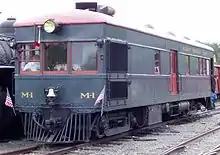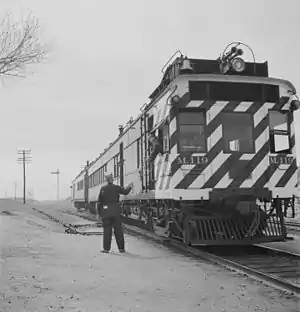Doodlebug (rail car)
Doodlebug or hoodlebug is a nickname in the United States for a type of self-propelled railcar most commonly configured with both passenger and freight (often dedicated baggage, mail and/or express, as in an unpowered combine) compartments.[1] The name is said to have derived from the perceived insect-like appearance of the units, as well as the slow speeds at which they would doddle or "doodle" down the tracks.[2] Early models were usually powered by a gasoline engine, with either a mechanical drive train or a generator providing electricity to traction motors ("gas-electrics"). In later years, it was common for doodlebugs to be repowered with a diesel engine.
| ”Doodlebug” | |
|---|---|
 East Broad Top No. M1, a narrow gauge gas-electric doodlebug that was constructed by EBT from a Brill manufactured kit | |
| Manufacturer | various, including EMC/Pullman, Brill/Mack, McKeen Motor Car Company, Rio Grande Southern Railroad |
| Specifications | |
| Car body construction | Coach/baggage combine |
| Prime mover(s) | various (gasoline, diesel) |
| Transmission | various (mechanical, electric, hydraulic) |
| AAR wheel arrangement | usually B-2 |
| Track gauge | 4 ft 8 1⁄2 in (1,435 mm) and 3 ft (914 mm) |
Doodlebugs sometimes pulled an unpowered trailer car, but were more often used singly. They were popular with some railroads during the first part of the 20th century to provide passenger and mail service on lightly used branch lines at less expense than with a train consisting of a locomotive and coaches with larger crew. Several railroads, mostly small regional and local networks, provided their main passenger services through doodlebugs in a cost-cutting effort.
History
The development of gasoline engines led railroads to seek them as higher efficiency alternatives to steam power for low-volume branch line services at the start of the 20th century. The McKeen railmotor was a line of self-propelled gasoline-powered railcars produced between 1905 and 1917. The 200 HP engine on the 55-foot long or 70-foot long units drove only one set of wheels, and the lack of power and traction, the unreliability of their transmissions, and an inability to reverse, were major limitations.[3] General Electric (“GE”) was the pioneer of gas-electric railcars: GE in February, 1906 rebuilt a wood passenger coach into a gas-electric unit which was placed in trial service on the Delaware and Hudson Railroad.[4] The St. Louis–San Francisco Railway was an early adopter of this technology, placing an initial order for ten gas-electric units in 1910 and seven additional by 1913, giving it the distinction of having the largest fleet of gas-electric motor cars in the country.[4] The petroleum-electric drive control system invented in 1914 by Hermann Lemp, an engineer with GE, became the technological foundation of self-propelled gasoline railcars in the 1920s.
In 1923 the Electro-Motive Company began production of self-propelled railcars, subcontracting bodies to the St. Louis Car Company, prime movers to the Winton Engine Company, and electrical equipment to General Electric. The Pullman Company was subsequently added as a subcontractor for car bodies.
Improvements to railcars were sought by The Pullman Company, who experimented with lightweight designs in partnership with the Ford Motor Company in 1925. They then enlisted the services of pioneering all-metal aircraft designer William Bushnell Stout in 1931 to adapt airplane fuselage design concepts to railcars.[5] Also in 1931 the Budd Company entered into a partnership with the French tire company Michelin to produce lightweight stainless steel Budd-Michelin railcars in the US. Those advances in lightweight railcar design were important steps in the development of the lightweight diesel-electric streamliners of the 1930s.
Production of self-propelled railcars dropped off with the onset of the Great Depression, which hurt the market for branch line services. But production was revived in 1949 with introduction of the Budd Rail Diesel Car.
The variant name hoodelbug was largely limited to the mid-Atlantic states, particularly Pennsylvania.[6] A major hiking trail in Indiana County, Pa., is named Hoodlebug Trail.[7]
The last remaining Atchison, Topeka and Santa Fe (ATSF) Gas-Electric Doodlebug, M.177, is on display at the City of Los Angeles "Travel Town Museum" in Griffith Park.[8]


See also
References
- American Rails: Doodlebugs
- "Doodlebugging on the Frisco, Part I." (PDF). All Aboard, The Frisco Railroad Museum, March, 1988 (accessed on CondrenRails.com). Retrieved October 10, 2020.
- "Streamliners are loved especially the stunning 1910 McKeen Motor Car". Ian Harvey, TheVintageNews.com, October 30, 2016. Retrieved October 12, 2020.
- "Doodlebugging on the Frisco, Part II" (PDF). All Aboard, The Frisco Railroad Museum, April, 1988 (accessed on CondrenRails.com). Retrieved October 10, 2020.
- Solomon, Brian (2015). Streamliners: Locomotives and Trains in the Age of Speed and Style, p. 32-33.
- Shawmut Line's Famous Hoodlebug
- Parks and Rec: Hoodlebug Trail
- "Travel Town Museum". www.laparks.org. Retrieved 2020-08-09.
- Dorin, Patrick C. (1972). Chicago and North Western Power. Burbank, California: Superior Publishing. pp. 182, 188. ISBN 0-87564-715-4.
Further reading
- Edmund Keilty (September 1979). Interurbans without wires: the rail motorcar in the United States. Interurbans. ISBN 978-0-916374-38-9.
- Edmund Keilty (September 1982). Doodlebug country: the rail motorcar on the Class 1 railroads of the United States. Interurban Press. ISBN 978-0-916374-50-1.
- Edmund Keilty (December 1988). The Short Line Doodlebug: Galloping Geese and Other Rail Critters. Interurban Press. ISBN 978-0-916374-77-8.
- John B. McCall (December 1977). The Doodlebugs. Kachina Press . ISBN 978-0-930724-01-6
External links
- Doodlebugs at american-rails.com. Retrieved October 10, 2012
- Doodlebugs in Jacksonville, Florida